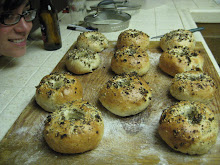A month or so ago, our short-lived post-doc Jamie invited the lab over for an impromptu lab meeting to watch him brew some beer. We ended up drinking a LOT of beer and playing the new Wii Super Mario Bros through to the end (we were there for many hours - go into a bubble!). Soon I hope to drink the beer he brewed that day, but to tide me over, I took the barley grains he used to brew the beer (the spent grains). I found
this recipe for spent grain bread a while ago and had been dying to try it, and once I got my hands on some spent grains I went to work.
This is another Reinhart recipe (from a book I don't have yet,
Whole Grain Breads) and the first thing I noticed is that it's 100% whole wheat. Now I love eating whole wheat bread, but in the past when I've tried to make it, I am always alarmed at how gooey and sticky the dough is and how hard it is to knead. It is frustrating and messy. The key to this recipe (which was a dream to make) is the biga and the soaker.
Basically, almost all of the flour used in this recipe is hydrated the day before. A soaker is just flour, salt, and water. Allowing the whole wheat to sit in water overnight helps release the sugars and softens the harder bran of the wheat. A biga is an overnight ferment, often used to impart additional flavor to a bread, and may also aid in gluten development. Using both for this recipe made the dough incredibly easy to knead, and hardly sticky at all because the flour had already evenly absorbed a lot of the moisture. I have never made a 100% whole wheat dough that was so easy to work with. Guess I have another book on the wish list!
I made small rolls, and they turned out delicious. At the top is a picture of them proofing, and you can see some of the spent grains in the bread. Depending on the beer brewed, the bread will have a slightly different flavor. I was unsure if I would like the flavor (I love beer, so I don't know why I was unsure) but it was wonderful. A little nutty and very complex, only faintly tasting of beer and barley, and excellent right out of the oven.
The other batch of bread I made that day were pain l'ancienne baguettes, which are my go to baguettes because they require minimal work, the baguette version of the
no-knead dutch oven bread, which I have actually never tried. This recipe is also from
BBA, and I have made it probably a dozen times.
Pain l'ancienne
- 6 cups/765 g unbleached bread flour
- 2 1/4 teaspoons salt
- 1 3/4 teaspoons instant yeast
- 2 1/4 to 3 cups/538-680g ice water (yes, ice water)
I take Brita water out of the fridge and add some ice, let it sit for about 5 minutes while I weigh out the other ingredients, and then mix the dough. I mix until the dough comes off of the sides, but still sticks to the bottom of the bowl. Add water or flour as necessary until this happens, then mix until it's homogeneous. Then cover the bowl with saran wrap and stick it in the fridge immediately.
The next day, a couple of hours before you are ready to make the bread, take the bowl out and put it on the counter. Leave it there for 2 or 3 hours, until the dough is noticeably bigger and no longer cold. At some point in this 3 hours, turn your oven on to 500 F and if you have a baking stone, let it heat up in there.
Now comes the only difficult part - prepare your kneading surface with 1/4 cup sprinkled flour, then pour the dough onto this flour so it doesn't stick to everything. Add a little more flour to the top and pat it into a rough square or circle, about 6-8 inches wide. Cut this in half, and let the dough rest for a few minutes. Prepare some parchment paper to be the right size (cookie sheet size). Cut each half of the dough into three strips, and stretch them out to the length of the cookie sheet. This takes a little practice, but even if they look ugly, they will still taste good, so don't worry. I'll try to remember to photograph this step the next time I make these. It should look something like this:

I put the parchment right on my baking stone. If you don't have one, you can bake these on the back of a cookie sheet. You want to steam up the oven when you first put them in. My method is to heat an old cookie sheet up on the bottom rack and boil some water. When I put the loaves in, I pour the boiling water on the cookie sheet (be really careful, I have gotten some wicked burns doing this absent-mindedly). You can also spray the walls of the oven with water from a spray bottle a couple times for the next minute. Then turn the oven down to 475 F and bake for 20-25 minutes, rotating once.
I cut the second half of the dough into strips while the first half is baking, and cover them with saran wrap until they are ready to go in the oven. I love this bread because it requires so little work, and I just keep them frozen until I need a nice baguette! They are also about a jillion times easier to make than traditional baguettes.

































